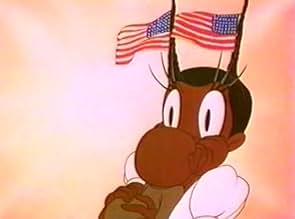IMDb RATING
6.1/10
1.7K
YOUR RATING
So White flees from the wicked Queenie, wins over the thugs from Murder Inc. and meets her overrated Prince Chawmin'.So White flees from the wicked Queenie, wins over the thugs from Murder Inc. and meets her overrated Prince Chawmin'.So White flees from the wicked Queenie, wins over the thugs from Murder Inc. and meets her overrated Prince Chawmin'.
Ivie Anderson
- Narrator
- (voice)
- (uncredited)
Ruby Dandridge
- Queen's Sweet Voice
- (voice)
- (uncredited)
- …
Vivian Dandridge
- So White
- (voice)
- (uncredited)
Lillian Randolph
- Mammy
- (voice)
- (uncredited)
Zoot Watson
- Prince Chawmin'
- (voice)
- (uncredited)
Danny Webb
- Queen
- (voice)
- (uncredited)
- Director
- Writers
- All cast & crew
- Production, box office & more at IMDbPro
Storyline
Did you know
- TriviaThis was the only short for which the animators at Warner Bros. did any research. They went to African American nightclubs to learn the slang.
- Quotes
Queen: De gal! And de prince! Wotta sickenin' sight!
Queen's Sweet Voice: [on telephone] Hello, Murder Incorporated?
Queen: [words appear on screen] BLACKOUT SO WHITE! *tears phone speaker off with her gapped teeth*
- Crazy creditsA unique "That's All, Folks!" card features an animated shot of Mammy and a little girl rocking in an armchair.
- ConnectionsEdited into Uncensored Cartoons (1982)
Featured review
In the late 1980's, a documentary titled Amos 'n Andy: Anatomy of a Controversy looked at the infamous comedy show. Despite the doc's own testimonials by famous black performers who found the show funny, the only way to get the show looked at or praised these days was to surround it with politically correct analysis.
That's most likely the only way that cable TV's Cartoon Network, which owns the rights to Bob Clampett's Snow White parody Coal Black an de Sebben Dwarfs (1943), would ever be able to air this cartoon. Most likely, the Cartoon Networkers won't consider even that ploy, as they have seen fit to remove any possible inflammatory material from their huge backlog of cartoons. That's a great pity, because most of those who have been fortunate enough to view Coal Black regard it as one of Bob Clampett's most jaw-droppingly funny creations.
As has been well documented elsewhere, the unfortunate fact is that, at the time of Coal Black's making, African-Americans were rarely treated as equals to whites on the silver screen. (Dooley Wilson's Sam in Casablanca [1942] is a notable exception, depicting a warm friendship with Humphrey Bogart's Rick. Yet even Sam clears out of the room as soon as Bogie and Ingrid Bergman, the movie's iconic white lovers, reunite.)
And unsubtle stereotypes abound. Just to hit the highlights, "Prince Chawmin'" is a jive-spouting hero with dice for teeth (and he literally turns yellow when So White calls for him to rescue her). "De Sebben Dwarfs" are little more than thick-lipped comic relief.
And the movie begins with the tale being told by a loving "mammy" to her child.
Yet the underlying irony is that the racial aspect is merely a smokescreen for what this cartoon is really about: sex. This film's Wicked Queen doesn't even consider whether she's the fairest one of all; her first words in the story are "Magic mirror on the wall, send me a prince about six feet tall." So White, far from Disney's virginal image of Snow White, wears a low-cut blouse and thigh-high shorts, and she sends blazes of erotic ecstasy through every male she meets. If it weren't for the movie's parody approach, it's difficult to believe that the same censors who got all worked up about Tex Avery's Red Hot Riding Hood series would have let Clampett get away with such brazenness.
The irony is that Bob Clampett intended his cartoon as a tribute to black culture. The movie's hot jazz score (by Eddie Beals) surpasses even Carl Stalling's usual high standards, with some incredible scat singing and white-hot trumpet playing. And So White is voiced by Vivian Dandridge, Dorothy Dandridge's sister, and the Evil Queen is voiced by their mother Ruby, which is enough to at least give the movie a legitimate pedigree. Beyond that, this cartoon is to Clampett's oeuvre what What's Opera, Doc? is to Chuck Jones's canon--a look at a Warner Bros. cartoon director at the height of his control. Like Jones's opera parody/tribute, Coal Black goes beyond funny to just plain astounding. Even in fifth-generation bootlegs, the cartoon is rich in the sort of frame-exploding work that has made Clampett's reputation. Even though many of the wartime references (to shortages and the military) date this cartoon far worse that most WB efforts, the jokes still come across quite clearly. (When Mammy tells us how rich the Evil Queen is, the camera pans across her riches: piles of stockpiled sugar and rubber tires.)
There is plenty to be offended about in Coal Black an de Sebben Dwarfs, if offense is all that you seek. But the most memorable cartoons are usually the ones that get somebody's dander up. In an era where Keenan Ivory Wayans makes the most profitable Afro-American movie ever (Scary Movie) by taking R-rated swipes at penises and mental retardation, surely there's room in our culture for a comparatively benign (and far funnier) six-minute cartoon.
That's most likely the only way that cable TV's Cartoon Network, which owns the rights to Bob Clampett's Snow White parody Coal Black an de Sebben Dwarfs (1943), would ever be able to air this cartoon. Most likely, the Cartoon Networkers won't consider even that ploy, as they have seen fit to remove any possible inflammatory material from their huge backlog of cartoons. That's a great pity, because most of those who have been fortunate enough to view Coal Black regard it as one of Bob Clampett's most jaw-droppingly funny creations.
As has been well documented elsewhere, the unfortunate fact is that, at the time of Coal Black's making, African-Americans were rarely treated as equals to whites on the silver screen. (Dooley Wilson's Sam in Casablanca [1942] is a notable exception, depicting a warm friendship with Humphrey Bogart's Rick. Yet even Sam clears out of the room as soon as Bogie and Ingrid Bergman, the movie's iconic white lovers, reunite.)
And unsubtle stereotypes abound. Just to hit the highlights, "Prince Chawmin'" is a jive-spouting hero with dice for teeth (and he literally turns yellow when So White calls for him to rescue her). "De Sebben Dwarfs" are little more than thick-lipped comic relief.
And the movie begins with the tale being told by a loving "mammy" to her child.
Yet the underlying irony is that the racial aspect is merely a smokescreen for what this cartoon is really about: sex. This film's Wicked Queen doesn't even consider whether she's the fairest one of all; her first words in the story are "Magic mirror on the wall, send me a prince about six feet tall." So White, far from Disney's virginal image of Snow White, wears a low-cut blouse and thigh-high shorts, and she sends blazes of erotic ecstasy through every male she meets. If it weren't for the movie's parody approach, it's difficult to believe that the same censors who got all worked up about Tex Avery's Red Hot Riding Hood series would have let Clampett get away with such brazenness.
The irony is that Bob Clampett intended his cartoon as a tribute to black culture. The movie's hot jazz score (by Eddie Beals) surpasses even Carl Stalling's usual high standards, with some incredible scat singing and white-hot trumpet playing. And So White is voiced by Vivian Dandridge, Dorothy Dandridge's sister, and the Evil Queen is voiced by their mother Ruby, which is enough to at least give the movie a legitimate pedigree. Beyond that, this cartoon is to Clampett's oeuvre what What's Opera, Doc? is to Chuck Jones's canon--a look at a Warner Bros. cartoon director at the height of his control. Like Jones's opera parody/tribute, Coal Black goes beyond funny to just plain astounding. Even in fifth-generation bootlegs, the cartoon is rich in the sort of frame-exploding work that has made Clampett's reputation. Even though many of the wartime references (to shortages and the military) date this cartoon far worse that most WB efforts, the jokes still come across quite clearly. (When Mammy tells us how rich the Evil Queen is, the camera pans across her riches: piles of stockpiled sugar and rubber tires.)
There is plenty to be offended about in Coal Black an de Sebben Dwarfs, if offense is all that you seek. But the most memorable cartoons are usually the ones that get somebody's dander up. In an era where Keenan Ivory Wayans makes the most profitable Afro-American movie ever (Scary Movie) by taking R-rated swipes at penises and mental retardation, surely there's room in our culture for a comparatively benign (and far funnier) six-minute cartoon.
Details
- Release date
- Country of origin
- Language
- Also known as
- Merrie Melodies #7 (1942-1943 Season): Coal Black and de Sebben Dwarfs
- Production company
- See more company credits at IMDbPro
- Runtime7 minutes
- Sound mix
- Aspect ratio
- 1.37 : 1
Contribute to this page
Suggest an edit or add missing content

Top Gap
By what name was Coal Black and de Sebben Dwarfs (1943) officially released in Canada in English?
Answer





















